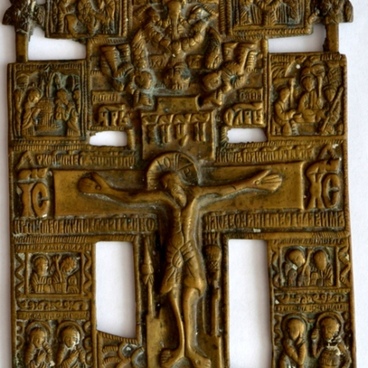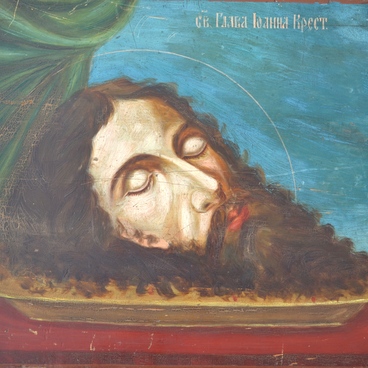The cross is the main symbol of Orthodox faith and one of the most important attributes of church services. Altar crosses were placed upon on the holy table of the altar, hence the name. They are used to bless believers; they are present at daily prayers and on holy days. It is the custom to kiss the cross after confession.
«Crucifixion of Christ» Altar Cross
Creation period
19th century
Dimensions
18,7x36 cm
18.7х36х0.5 cm
18.7х36х0.5 cm
Technique
Cast copper alloy, enamels
Collection
Exhibition
7
Open in app#1
Unknown Author
‘Crucifixion of Christ’ Altar Cross
#3
Another name of the altar cross is Golgothan. It appeared in commemoration of Mount Golgotha which was not far from Jerusalem. It was there that the cross on which Jesus Christ was crucified stood. Altar crucifixes of the 19 the century were traditionally cast from a copper alloy using specially prepared wooden molds. They were eight-pointed big crosses, up to 40 centimetres tall.
#6
The central figure of the crucifix is Jesus Christ. According to the orthodox tradition, the Saviour’s feet and palms are nailed to the cross with four nails. In Catholic icons, the feet are nailed with one nail. Above Jesus’ head there is God the Father, or Lord Sabaoth, sitting in the clouds. God the Father is depicted bust-length, and there are two praying angels on either side of him. Sabaoth and the angels symbolise acceptance of Jesus Christ who died for human sins back to heaven.
The skull of Adam is an indispensable image for crucifixes. It is placed under Christ’s feet, sometimes in a cave at the foot of the mount, sometimes without it. It is believed that redemption of human sins happened when the saviour’s blood washed the skull and the bones of the first man. According to the Gospel texts, Adam’s body had been deliberately buried at the place of Christ’s future execution.
The skull of Adam is an indispensable image for crucifixes. It is placed under Christ’s feet, sometimes in a cave at the foot of the mount, sometimes without it. It is believed that redemption of human sins happened when the saviour’s blood washed the skull and the bones of the first man. According to the Gospel texts, Adam’s body had been deliberately buried at the place of Christ’s future execution.
#2
‘Crucifixion of Christ’ Altar Cross (obverse and reverse sides)
#7
There are a lot of inscriptions on the cross. Depicted on the lower bar which is at an angle are the towers of Jerusalem, and next to them we see embossed Cyrillic letters ‘НИКА’, ‘МЛPБ’ and ‘ГГ’. The first one is the name of a Christian martyr, who, like Christ, suffered for her faith. Besides, this word (Nike) means ‘victor’ in Greek. The letters ‘МЛPБ’, if translated from Russian, spell out as ‘the Place of the Skull is Paradise’, which means that after Jesus’ death, the Gates of Paradise opened for him and for the righteous people at the place of his execution. The Cyrillic letters “ГГ” is an abbreviated name for “Golgotha”.
The translation of the embossed text above the Saviour’s nimbus and on either side of him reads: ‘King of Glory Son of God’. This is meant to confirm his divine nature and the triumph of the Christian faith on earth. Inscribed above the upper edge of the middle bar is Christ’s abbreviated name, and the translation of the text in the lower part of the bar is as follows: “Thy Cross do we adore, O Lord, and thy holy Resurrection do we glorify”.
The crucifix is decorated with a cast ornament, which looks like pearls strung along the contour of the cross. The cross is covered with blue enamel. The reverse surface is smooth and has the text of the prayer to the cross over it. This is the kind of crosses that were made by Old Believer masters in the 19th century.
The crucifix is decorated with a cast ornament, which looks like pearls strung along the contour of the cross. The cross is covered with blue enamel. The reverse surface is smooth and has the text of the prayer to the cross over it. This is the kind of crosses that were made by Old Believer masters in the 19th century.
#8
Iskitim Municipal Museum of Arts and History
read morehide
00:00
00:00
1x
«Crucifixion of Christ» Altar Cross
Creation period
19th century
Dimensions
18,7x36 cm
18.7х36х0.5 cm
18.7х36х0.5 cm
Technique
Cast copper alloy, enamels
Collection
Exhibition
7
Open in app
Share

